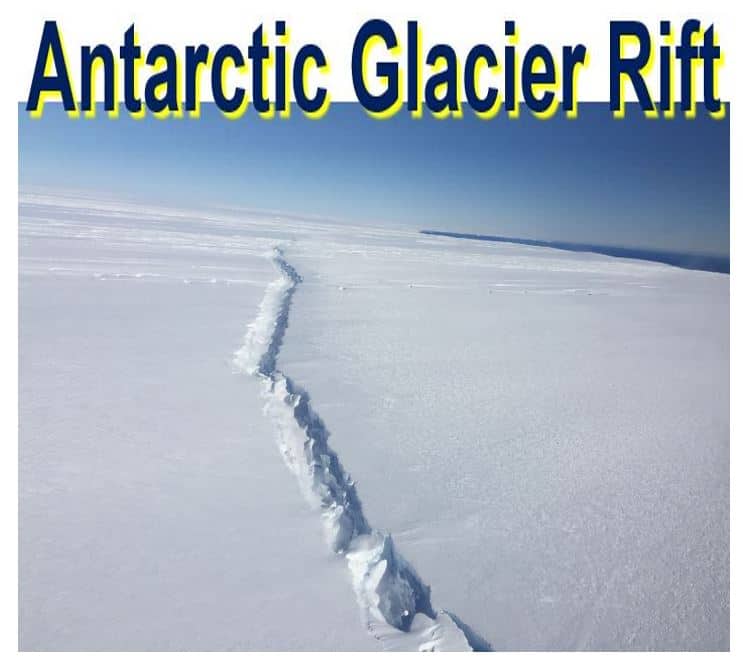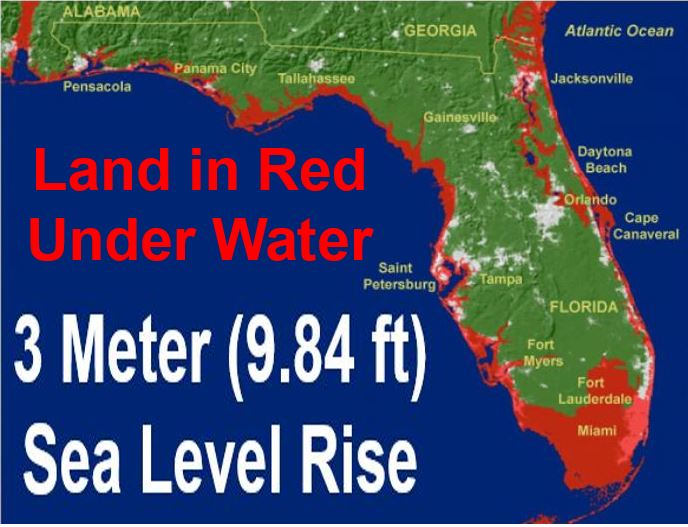A major Antarctic glacier is falling apart – but this time from the inside out, says a team of scientists. Their findings suggest that the ocean is weakening the ice on Antarctica’s edges. The discovery was made while Ohio State University and the University of Michigan researchers were testing some new image-processing software.
The Pine Island Glacier, a huge ice stream Antarctic glacier, is currently responsible for approximately one quarter of Antarctica’s ice loss. It is part of the ice shelf that bounds the West Antarctica Ice Sheet.
Scientists say that this Antarctic glacier is one of two that are most likely to undergo rapid retreat, bringing ice from far inside the interior of the ice sheet to the sea.
 In this image you can see the rift in the Pine Island Glacier ice shelf in West Antarctica. The image was captured during a NASA Operation IceBridge survey flight on Nov 4th, 2016. It is the second rift to form in the ice shelf’s center in the past three years. (Image: news.osu.edu. Credit: NASA/Nathan Kurtz)
In this image you can see the rift in the Pine Island Glacier ice shelf in West Antarctica. The image was captured during a NASA Operation IceBridge survey flight on Nov 4th, 2016. It is the second rift to form in the ice shelf’s center in the past three years. (Image: news.osu.edu. Credit: NASA/Nathan Kurtz)
If this mega Antarctic glacier melts…
If just this giant Antarctic glacier were to melt completely, many coastal cities, towns and villages across the world would be flooded.
Last year, an almost 225-square-mile (582-sq-km) iceberg broke off from the glacier. However, it was not until scientists at Ohio State and Michigan Universities were testing their new image-processing software that they detected something unusual in the satellite images that had been captured before the event.
In the pictures, they detected evidence that a rift had formed at the very base of the ice shelf, almost twenty miles (32 km) inland in 2013. Over a two-year period, the rift had propagated upward, until it eventually broke through the surface of the ice and set the iceberg adrift for a period of twelve days in 2015 during late July and early August.
Study leader, Ian Howat, associate professor of earth sciences at Ohio State, and colleagues wrote about their study and findings in the prestigious journal Geophysical Research Letters (citation below).
 Ian Howat, Associate Professor, Head of Water, Climate and Environment Division Regular Faculty at Ohio State University. He is a glaciologist focused on dynamic of ice sheets and glaciers, and particularly their rapid respond in climate forcing. (Image: earthsciences.osu.edu)
Ian Howat, Associate Professor, Head of Water, Climate and Environment Division Regular Faculty at Ohio State University. He is a glaciologist focused on dynamic of ice sheets and glaciers, and particularly their rapid respond in climate forcing. (Image: earthsciences.osu.edu)
West Antarctic Ice Sheet will melt
Prof. Howat said:
“It’s generally accepted that it’s no longer a question of whether the West Antarctic Ice Sheet will melt, it’s a question of when.”
“This kind of rifting behavior provides another mechanism for rapid retreat of these glaciers, adding to the probability that we may see significant collapse of West Antarctica in our lifetimes.”
This is the first time scientists have observed a deep subsurface rift opening within Antarctic ice. Similar breakups have been witnessed in the Greenland Ice Sheet – in areas where sea water has seeped inland along the bedrock and started to melt the ice from below.
According to Prof. Howat, the satellite images have given us the first pieces of compelling evidence that these huge Antarctic ice shelves respond to changes at their ocean edge in much the same was as has occurred in Greenland.
Antarctic glacier rift started from center of ice shelf
Prof. Howat explained:
“Rifts usually form at the margins of an ice shelf, where the ice is thin and subject to shearing that rips it apart. However, this latest event in the Pine Island Glacier was due to a rift that originated from the center of the ice shelf and propagated out to the margins.”
“This implies that something weakened the center of the ice shelf, with the most likely explanation being a crevasse melted out at the bedrock level by a warming ocean.”
 If the sea level rises by nearly ten feet – an increase mentioned in this study – Florida would be devastated, as would most seaside cities, towns and villages in the United States. Countries such as The Netherlands and Bangladesh would see most of their land flooded with sea water. (Image: catholic.org)
If the sea level rises by nearly ten feet – an increase mentioned in this study – Florida would be devastated, as would most seaside cities, towns and villages in the United States. Countries such as The Netherlands and Bangladesh would see most of their land flooded with sea water. (Image: catholic.org)
The scientists also noticed another clue – the rift opened in the lower part of a ‘valley’ in the ice shelf where the ice had become considerably thinner than the surrounding ice shelf.
The researchers believe that the valley is a sign of something they have long suspected: Given that the West Antarctic Ice Sheet is below sea level, sea water can get in and make its way a long distance inland – undetected.
New valleys sign of melting ice
New valleys being formed on the surface would be a clear outward sign that ice far below was melting.
The origin of the rift in this giant Antarctica glacier – Pine Island Glacier – would have gone undetected too, except that the Landsat 8 Images that Prof. Howat and colleagues were analyzing happened to be taken when the Sun was quite low in the sky.
The long shadows that were cast across the ice caught the scientists’ attention, and they saw that a valley that had been forming there.
 Pine Island Glacier is a massive ice stream that drains the West Antarctic Sheet into the ocean. (Image: svs.gsfc.nasa.gov)
Pine Island Glacier is a massive ice stream that drains the West Antarctic Sheet into the ocean. (Image: svs.gsfc.nasa.gov)
Prof. Howat said:
“The really troubling thing is that there are many of these valleys further up-glacier. If they are actually sites of weakness that are prone to rifting, we could potentially see more accelerated ice loss in Antarctica.”
Disaster awaits coastal communities
Antarctica holds more than half of all the fresh water on our planet – in frozen form. The Pine Island Glacier and the Thwaites Glacier, its nearby twin, sit at the outer edge of one of Antarctica’s most active ice streams.
This Antarctic glacier and its twin are like corks in a bottle, blocking the ice flow and keeping almost ten percent of the West Antarctic Ice Sheet from draining into the ocean.
According to studies, the West Antarctic Ice Sheet is very unstable – it could collapse within the next century.
If or when it collapses, global sea-level could rise by almost ten feet (3 meters), which would engulf hundreds of cities across the world including Miami, Cancun, New York, much of East Anglia in England, huge areas of The Netherlands and Bangladesh, and displace more than 150 million people globally.
Prof. Howat said:
“We need to understand exactly how these valleys and rifts form, and what they mean for ice shelf stability. We’re limited in what information we can get from space, so this will mean targeting air and field campaigns to collect more detailed observations.”
“The U.S. and the U.K. are partnering on a large field science program targeted at that area of Antarctica, so this will provide another piece to the puzzle.”
In an Abstract preceding the main paper in the journal, the authors wrote:
“Coincident with rift formation was the sudden disintegration of the ice mélange that filled the northern shear margin, resulting in ice sheet detachment from this margin.”
“Examination of ice velocity suggests that this internal rifting resulted from the combination of a change in ice shelf stress regime caused by disintegration of the mélange and intensified melting within basal crevasses, both of which may be linked to ocean forcing.”
Citation: “Accelerated ice shelf rifting and retreat at Pine Island Glacier, West Antarctica,” Seongsu Jeong, Ian M. Howat & Jeremy N. Bassis. Geophysical Research Letters. 28 November, 2016. DOI: 10.1002/2016GL071360.
Video – Antarctic glacier breaking up
This Ohio State Experts video shows how a deep subsurface rift has cracked through the ice nearly twenty miles inland – a sign that the largest ice reserve on Earth may be melting sooner than we realized.

